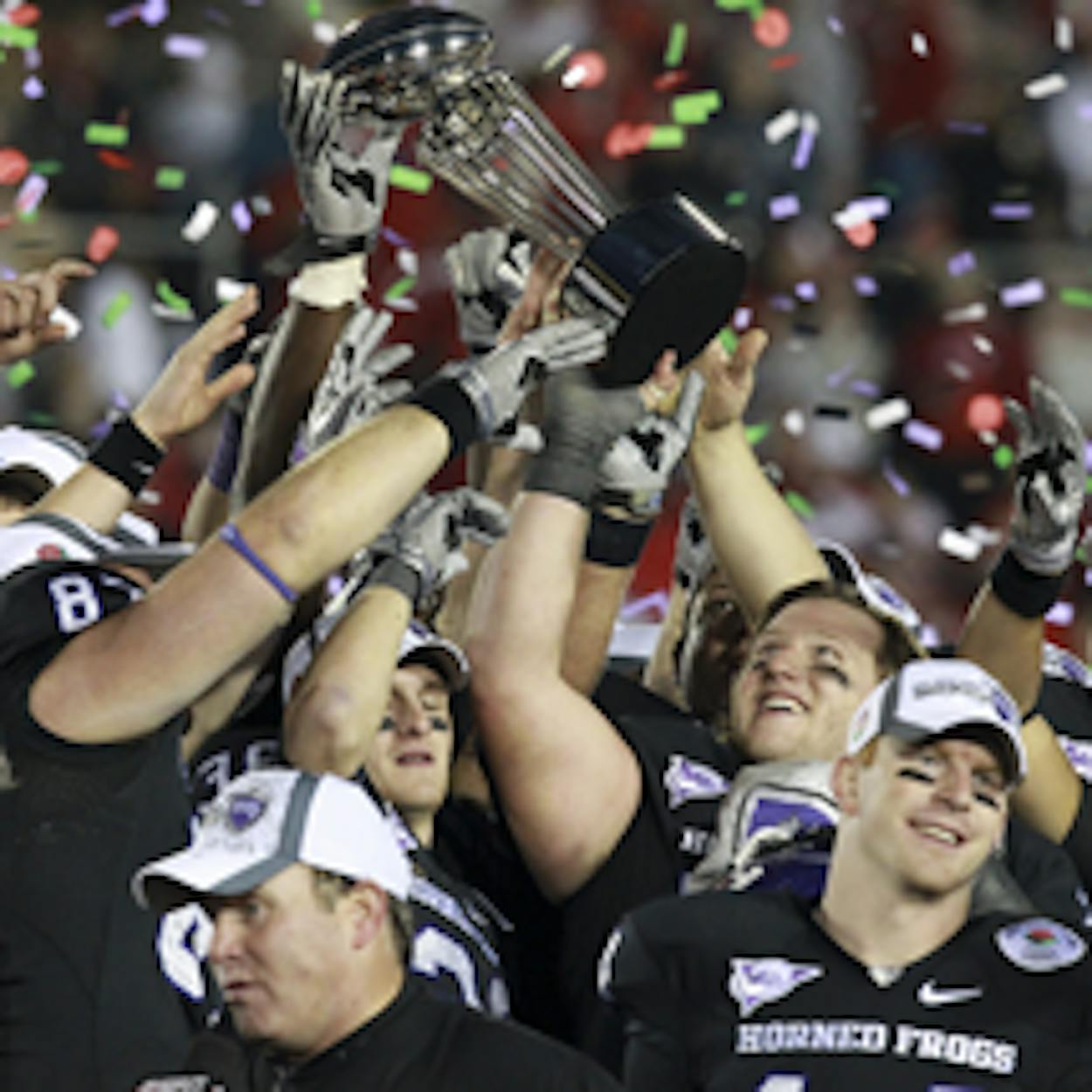Only one born to the purple, such as my old friend Dan Jenkins, can fully appreciate the sweetness of TCU’s Rose Bowl victory over Wisconsin on New Year’s Day. Jenkins has been waiting for this since the thirties, when TCU was one of the great football powers, with two national championships, a Heisman trophy winner, a couple of Sugar Bowl championships, a number of all-Americans, and two of the most prolific passers of all time—Sammy Baugh and Davey O’Brien. But, alas, the Rose Bowl invite, the prize of prizes of college football in those days, always seemed to get lost in the mail.
I was too young to be part of it, but the glamour of Fort Worth and TCU in the thirties is a big part of my heritage. Growing up in Arlington, I read about it every chance I got, in one of the TCU yearbooks my Aunt Dot kept in her living room, and later in Jenkins’ books and articles. Even today I get a little lightheaded reliving the romance that I’ve always associated with that time in history—three-day trips aboard special trains to California to play Santa Clara or to New York to play Fordham, with stops along the way so the team could practice. Coach Dutch Meyer, a wad of tobacco in his jaw, looking for a place to spit. The long stretch up University Boulevard to the campus, the sound of the TCU band, the thrill of purple and white.
In 1938 the Frogs finished far ahead of the field in the AP poll, but the Rose Bowl’s host team, Southern California, didn’t want any part of TCU’s explosive offense and put pressure on the bowl’s invitation committee to bypass the Frogs and opt instead for Duke, a team that—as Meyer noted at the time—“scored less points in a season than we did in one game.”
In the forties my Boy Scout troop ushered at TCU home games, and for three seasons I didn’t miss a play. I nearly died of pneumonia after watching TCU play Arkansas in a cold, driving rain. When I was studying at TCU on the GI Bill in the mid-fifties and Jenkins and I were becoming friends, the Horned Frogs featured the best halfback in school history, the incomparable Jim Swink. Sportswriters choked trying to conjure up adjectives to describe Swink’s dazzling, gliding, phantom-on-the-prowl style of running. Only Abe Martin, who by then had replaced Meyer as TCU’s coach, found the right words: “Aw,” Abe drawled, chewing on his cigar, “he’s just a little old rubber-legged outfit nobody can catch.” The Frogs dominated Southwest Conference football that decade. I was in the Cotton Bowl after the 1955 season when the Frogs lost to Ole Miss by a single point, mainly because star quarterback Chuck Curtis was injured on the opening kickoff, and I was there again the next year when we beat Syracuse and the great Jim Brown, again by a margin of a single point. Still, the Rose Bowl pretended TCU wasn’t a serious player.
This year’s Rose Bowl invitation was supposed to be TCU’s consolation prize from the BCS, for not allowing the Frogs, despite their second consecutive undefeated regular season, to play for the national championship. Quarterback Andy Dalton—not Baugh or O’Brien—now holds the record for the most career wins as a Frog, with 44. Thousands of fans joined the swell of purple washing across half of the stadium, among them Dan and June Jenkins, who hardly ever miss a game, no matter where it is played. “What a trip, what a game, what a win,” Dan wrote in an email after returning home. “I have to say this is the greatest win in TCU history. A TV audience of 20 million. A fantastic recruiting tool. Wisconsin’s band has more people than TCU has alumni! But the little old private school prevailed. I can only hope that it helps redefine the national college football landscape, but you can’t count on the BCS drones to have any sense.”
As the TV announcers kept reminding everyone, TCU is a small school. Something like nine thousand students, which is about the size of a freshman algebra class at UT. But I think “small” is another way of saying manageable. When I was a student there, I knew the names of most of the students I passed on campus, and they knew mine. What I remember most about my time at TCU is watching Swink do his magic and hearing stories about how Bob Lilly and a couple other linemen dismantled some poor student’s Volkswagen and reassembled it on the top floor of Tom Brown Hall. I can only hope that the students there now are enjoying that same kind of magic. And who knows? With TCU headed to the Big East Conference, maybe a future graduating class will celebrate yet another generation of heroes—and another national championship.








